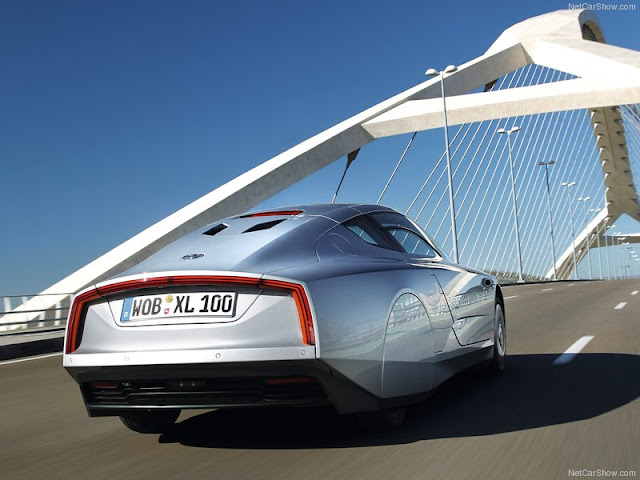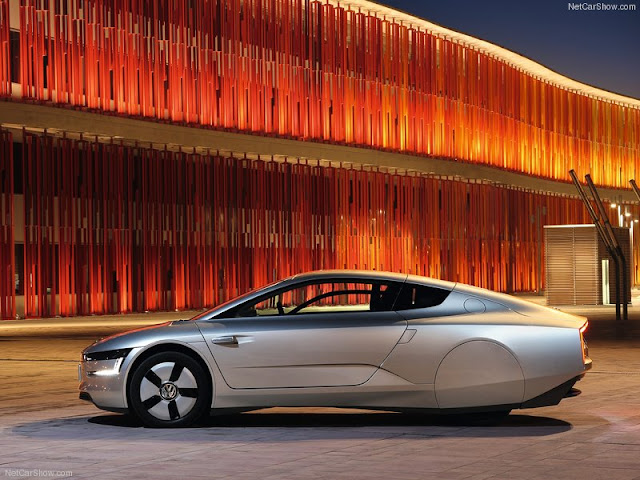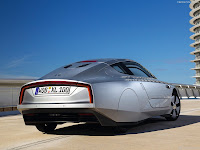Conceptually, the XL1 represents the third evolutionary stage of Volkswagen's 1-litre car strategy formulated in 2002 by the visionary goal of bringing to market a production car that was practical in everyday use with fuel consumption of one litre per 100 km.
2014 Volkswagen XL Sport Concept
Based on the XL1, the most fuel-efficient production car of all time, this 168-mph machine is a compelling blend of efficiency and emotion.The XL Sport houses one of the finest achievements in engine technology—the V-Twin adapted from the new Ducati 1199 Superleggera, the world's most powerful two-cylinder motorcycle. Like the XL1, of which only 250 will be built, the Superleggera is also being manufactured in a limited edition of 500 units, using a process that embraces hand fabrication and high-precision industrial manufacturing.
The world's most powerful two-cylinder engine. The Ducati 1199 Superleggera's V-Twin engine was slightly modified for use in the XL Sport, but is basically the same as the motorcycle’s. The 1199 cc double-overhead-camshaft engine can rev up to 11,000 rpm. Like the XL1, the central monocoque and most of the body panels are manufactured in carbonfiber-reinforced polymer (CFRP) using the RTM (Resin Transfer Molding) process. The monocoque features slightly offset seats for the driver and passenger. Whereas the XL1 is at its widest at the front and tapers towards the rear, the XL Sport is just as wide at the back as at the front. Like the XL1, there are no conventional door mirrors: instead, they are replaced by e-Mirrors, small streamlined cameras integrated in the fenders that send images of the surroundings behind the car to two displays inside the vehicle. The wing doors swivel upwards and slightly forwards as well. They also extend far into the roof, giving an exceptionally large amount of entry and exit space. In order to keep the weight as low as possible, the windows are made from polycarbonate and are fixed in place: just a segment of the lower area of the side windows can be opened.
The world's most powerful two-cylinder engine. The Ducati 1199 Superleggera's V-Twin engine was slightly modified for use in the XL Sport, but is basically the same as the motorcycle’s. The 1199 cc double-overhead-camshaft engine can rev up to 11,000 rpm. Like the XL1, the central monocoque and most of the body panels are manufactured in carbonfiber-reinforced polymer (CFRP) using the RTM (Resin Transfer Molding) process. The monocoque features slightly offset seats for the driver and passenger. Whereas the XL1 is at its widest at the front and tapers towards the rear, the XL Sport is just as wide at the back as at the front. Like the XL1, there are no conventional door mirrors: instead, they are replaced by e-Mirrors, small streamlined cameras integrated in the fenders that send images of the surroundings behind the car to two displays inside the vehicle. The wing doors swivel upwards and slightly forwards as well. They also extend far into the roof, giving an exceptionally large amount of entry and exit space. In order to keep the weight as low as possible, the windows are made from polycarbonate and are fixed in place: just a segment of the lower area of the side windows can be opened.
The XL Sport is longer and wider than the XL1 because of the need for additional downforce on a 168-mph car and because of the packaging requirements of the chassis and powertrain. (ultimatecarpage.com)
(Photos from supercars.net & ultimatecapage.com)
2014 Volkswagen XL1 Concept
The XL1 from Volkswagen is the most fuel-efficient production car in the world, with a fuel consumption value of 0.9 l/100 km. Thanks to its plug-in hybrid system, the two-seater can also cover a distance of up to 50 km in all-electric mode and therefore with zero local emissions. High-tech lightweight carbon-fibre body design, perfect aerodynamics and a plug-in hybrid system - consisting of a two-cylinder TDI engine (35 kW / 48 PS), E-motor (20 kW / 27 PS), 7-speed dual clutch gearbox (DSG) and lithium-ion battery - all make it possible for the new Volkswagen XL1 to emit just 21 g/km of CO2. If necessary, the XL1, with a top speed of 160 km/h, can accelerate to 100 km/h in just 12,7 seconds. 0.9 l/100 km fuel consumption is a record figure that has not been achieved by any other vehicle to date. (ultimatecarpage.com)
(Photos from netcarshow.com & conceptcarz.com))
2009 Volkswagen L1 Concept
2nd evolutonary stage of VW's 1-litre car strategy.
2003 Volkswagen 1-litre car Concept
1st generation of VW's 1-litre car strategy.







































































